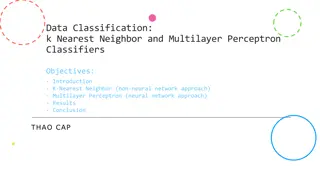Computational Physics (Lecture 18)
Neural networks explained with the example of feedforward vs. recurrent networks. Feedforward networks propagate data, while recurrent models allow loops for cascade effects. Recurrent networks are less influential but closer to the brain's function. Introduction to handwritten digit classification
1 views • 55 slides
Multi-Head Attention Layers in Transformers
Sitan Chen from Harvard presents joint work with Yuanzhi Li exploring the provable learnability of a multi-head attention layer in transformers. The talk delves into the architecture of transformers, highlighting the gap between practical success and theoretical understanding. Preliminaries, prior w
5 views • 38 slides
Artificial Neural Networks From Scratch
Learn how to build artificial neural networks from scratch, focusing on multi-level feedforward networks like multi-level perceptrons. Discover how neural networks function, including training large networks in parallel and distributed systems, and grasp concepts such as learning non-linear function
6 views • 33 slides
Data Classification: K-Nearest Neighbor and Multilayer Perceptron Classifiers
This study explores the use of K-Nearest Neighbor (KNN) and Multilayer Perceptron (MLP) classifiers for data classification. The KNN algorithm estimates data point membership based on nearest neighbors, while MLP is a feedforward neural network with hidden layers. Parameter tuning and results analys
0 views • 9 slides
Advanced Topics in Control System Design and Implementation
Delve into the complexities of control system design, from system identification to modern control techniques. Explore the challenges of designing controls for systems like interferometers and discuss the integration of classical and modern control theories. This workshop offers insights on optimal
1 views • 19 slides
Neural Response Variability and Connectivity Dynamics
Explore the intricate relationship between feedforward, feedback, and response variability in neural networks. Dive into the impact of noise on effective connectivity and network topology, as well as the challenges posed by noisy and delayed communication between brain regions. Discover the applicat
5 views • 14 slides
Learned Feedforward Visual Processing Overview
In this lecture, Antonio Torralba discusses learned feedforward visual processing, focusing on single layer networks, multiple layers, training a model, cost functions, and stochastic gradient descent. The content covers concepts such as forward-pass training, network outputs, cost comparison, and p
3 views • 32 slides
LeapForward Training Resource Toolkit(2018)
This toolkit from LeapForward provides invaluable resources for effective transition to the workplace. Focusing on feedforward principles, it equips learners with practical strategies to thrive in professional environments. The comprehensive guide covers a wide range of topics essential for success,
0 views • 26 slides
Process Control Loops & Control Schemes
This content delves into types of process control loops including feedback, feedforward, ratio, cascade, and split range control schemes. It explains feedback control in detail, its advantages, disadvantages, and provides examples. Furthermore, it covers constructing feedback control loops for diffe
0 views • 41 slides
Neural Networks and Machine Learning in Science
Explore the applications of neural networks and machine learning in physics research, biology, and supervised learning. Learn about mathematical neurons, feedforward neural networks, classification problems, and loss functions in network training.
3 views • 22 slides
Building Neural Networks from Scratch: Focus on Multi-level Perceptrons
In this comprehensive guide, you will learn to construct artificial neural networks from the ground up, with an emphasis on multi-level feedforward neural networks. Dive into the training process of large neural networks in parallel and distributed systems, and explore programming assignments center
0 views • 33 slides
Advanced Regulatory Control in Process Management
Explore the fundamentals of PID control, feedback vs. feedforward techniques, and the significance of notation and block diagrams in advanced regulatory control. Learn about PID tuning, feedback mechanisms, and the integration of feedforward control to enhance process efficiency.
1 views • 27 slides
Advanced Robotics - Computed Torque Control by Sangsin Park, Ph.D.
Explore the concept of Computed Torque Control in Advanced Robotics through an in-depth explanation by Sangsin Park, Ph.D. This involves feedback linearization, feedforward and feedback loops, derivation of control laws, and PD/PID controllers for outer loop stability.
3 views • 11 slides
Universal Approximation Theorem in Neural Networks
Explore the Universal Approximation Theorem, which states that a feedforward single hidden layer network can approximate continuous functions under mild assumptions on the activation function. Learn about practical and theoretical uses, including replicating black box functions, visualization tools,
1 views • 46 slides
Feedforward Control Process NMBU Dec 2017 April 2018
Explore the course on Feedforward Control by Finn Aakre Haugen, focusing on faster disturbance compensation and setpoint tracking. Learn about implementing feedforward controllers in temperature and level control systems with the help of simulators.
3 views • 14 slides
Neural Networks: Overview and Feedforward Networks in Pattern Recognition
Explore the fundamentals of neural networks in pattern recognition, including feedforward networks and their computations. Learn about nonlinearities, hidden layers, and the power of neural networks in machine learning.
3 views • 27 slides















